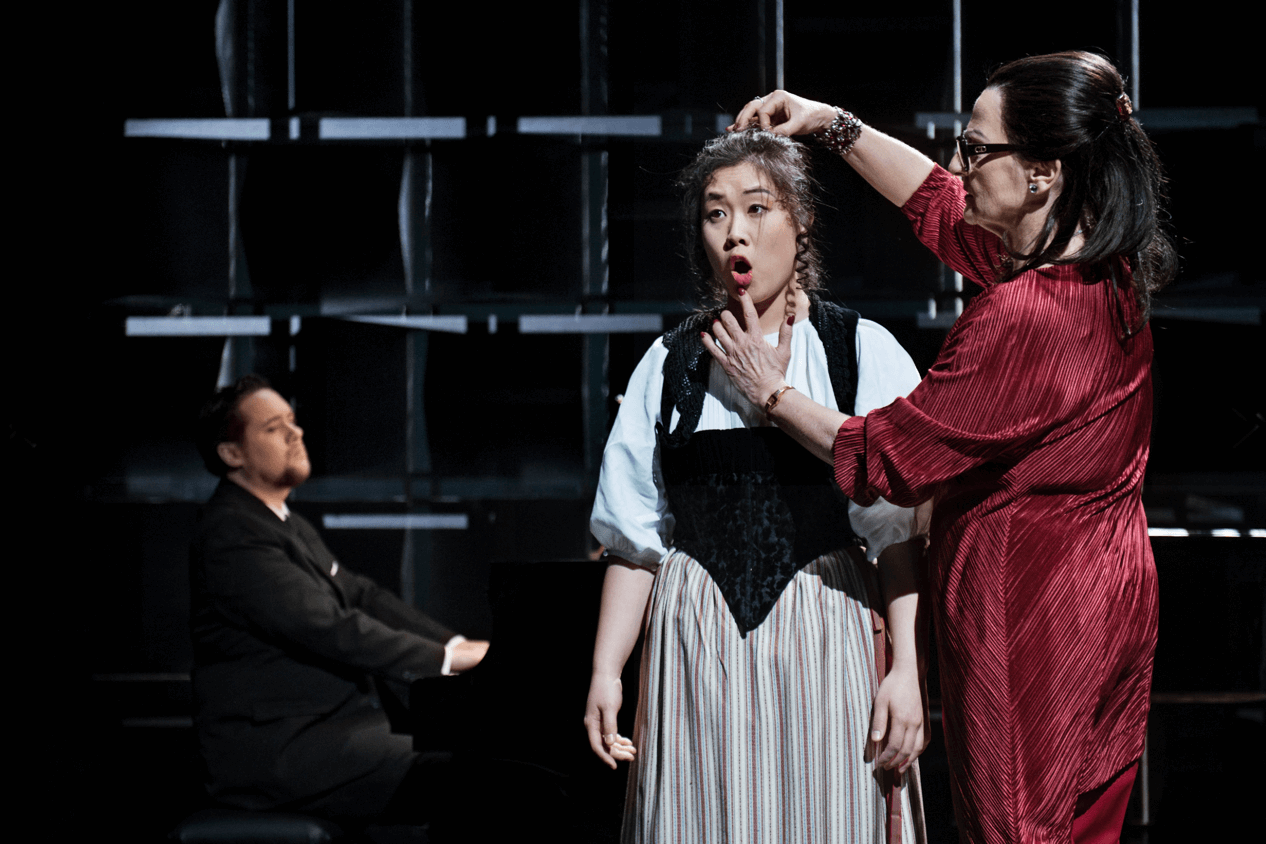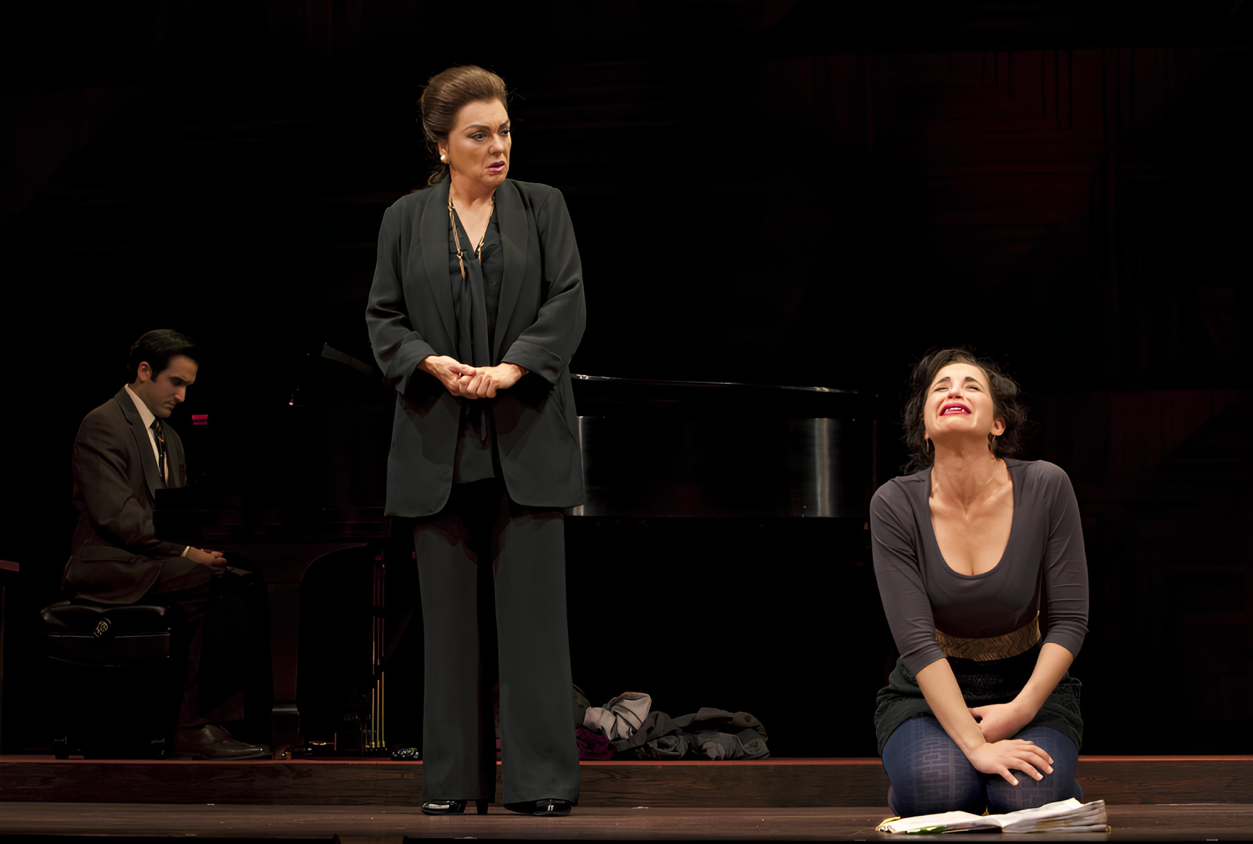The vocal metaphor
Metaphors are powerful cognitive tools that can shape the understanding and perception of the voice, sometimes completely replacing the underlying somatic reality. In voice education, metaphors are often used to guide body parts that are impossible to touch but risk becoming technical abstractions that obscure the truth of lived organs.
This study aims to analyze the role of metaphors in voice education, focusing on their cognitive functions. It seeks to identify consistent psychophysical principles across different metaphor choices in apparently contrasting pedagogical traditions. Additionally, the study integrates its findings with contemporary metaphor theory to assess implications for training and performance.

Master Class by Terrence McNally, directed by Dieter Kaegi, Theatre Orchestra Biel Solothurn, 2017.
Voice education between somatics and metaphor
Somatics—the study of the body as experienced from within—forms a crucial foundation for understanding CRIV’s approach to voice education. The use of metaphors in voice training and self-training is a widespread practice aimed at helping students develop vocal skills and understanding. However, the effectiveness of metaphors in conveying vocal mechanics and the associated sensations warrants careful consideration.
Despite the recognized benefits of metaphorical language, integrating or deconstructing vocal practices hidden behind nuanced verbal imagery may pose challenges for the voice-in-training. This underscores the critical need for clear communication and mutual understanding.
This ongoing research explores an approach to the problem that is informed by somatics. A somatic approach to voice education stresses the exploratory question “what happens?” over the prescriptive “what to do?”—promoting a shift away from traditional, directive vocal training methods based on metaphor use.
The “somatic approach” is therefore put in contrast with the “metaphorical approach,” notwithstanding that one is traditionally influenced by the other.
Verbal imagery
The study involves a comparative analysis of the metaphorical language used in different pedagogical traditions, such as Italian opera singing, the Wolfsohn/Hart tradition, Body Mind Centering, and extended vocal techniques.
The verbal imagery examined includes common metaphors such as “appoggio” and “singing from the back of your head,” as well as less typical metaphors such as “to contact the pelvic floor”, “to pull in the oars”, or “pushing the wall,” and images such as “voluntary-involuntary muscles” or “good and bad tension”.
The findings so far reveal that despite differences in metaphor choice, distinct pedagogies align on the same psychophysical realities. The focus is on drawing awareness towards different feelings of resonance and breath control.
Vocal transformability
Given that each learning process is unique and every student progresses at their own pace, ambiguous metaphorical language can lead to confusion and distress.
Voice education is not an “abstract education,” as often said (Kar 2021) – it proves tangible and transformative through its power to affect the meat of the body. Abstraction is traditionally introduced by the metaphorical approach.
The study proposes the wicked problem lens (Sediri et al., 2020; Termeer, Dewulf & Biesbroek, 2019) alongside the transformative learning lens (Mezirow, 1978; Argyris & Schön, 1978; O’Toole & Dunn, 2002; Schön, 1997) to address this problem, exploring voice education as a learning environment characterized by unique challenges, lack of definitive solutions, and issues of access. Our proposal lies in the concept of vocal transformability: the inherent possibility and the cultivated ability to transform what a voice does.

Master Class by Terrence McNally, directed by Stephen Wadsworth at Samuel J. Friedman Theatre, 2011.
The wicked problem of transformability
The term “transformability” derives from the literature on social-ecological systems, sustainability, resilience, and wicked problems (Sediri et al., 2020; Rittel & Webber, 1973). At a close look, voice education itself presents the characteristics of a wicked problem:
- It is uniquely complex, lacking clear definitions and definitive solutions.
- Outcomes are judged as good or bad rather than true or false.
- Each voice is unique and symptomatic of deeper issues.
- Training demands solutions without much tolerance for fiasco.
- It does not come cheap.
Approaching learning in terms of transformation may offer a path towards an ethical approach to the wicked problem of voice education, since there is no formation without transformation and no transformation without transformability. In other words, there cannot be voice education without access to vocal transformability. But transformability must be actively habilitated, while transformation can be passively received (think of vocal fold trauma).
Issues of access
Are we aware of the extent to which universal aspects of vocal habilitation are protected under copyright by educators who have an interest in keeping the veil of elusive and exclusive metaphors on top of inclusive and universal practices?
The lesson of transformative learning is central: A voice-in-training is not merely a receptor of phonatory expertise but a vocal inquirer, capable of addressing the physiological, acoustic, and perceptual problems they encounter.
This raises the central question of autonomy: how can we make learners vocal inquirers and not just receptors of phonatory expertise? The answer does not lie in metaphorical language. Rather than replacing reflection on the transformative experience, metaphors should trigger the transformation itself. The “somatic approach” encourages students to explore beyond the surface of language, while educators emphasize the situated knowledge that informs learning.
Through the introduction of implicit changes (at the level of the lived body), explicit changes emerge (at the level of sonic materiality). Such is the essence of vocal inquiry: enabling students to become independent in their vocal research.
From “What to do?” to “What happens?”: Voice training between somatics and metaphor, presented at Psychology and Music – Interdisciplinary Encounters, University of Zagreb.
The constitution of voices
Voice education extends beyond the limits of the exclusive field of singer training. But music can support such inclusivity.
Music learning shows us something about the constitution of voices—the process of negotiation that determines our place in society—and the constitution of voices—at the material level, at the level of the vocal sound—tells us something about the processes by which identities are formed, deformed, and reformed every day. Far beyond the art of singing, voice education—a practice of transmission of transformation—produces positive effects on the experience of the world as a relationship. The field of action deals with the issue of changing practices and perspectives, and this has potential effects on how identities are (trans)formed.
Through a combination of practice-led, practice-based, and theoretical research, this ongoing work aims at better defining the metaphor function in vocal study as a way towards a redefinition of what could be called the ethics of voice education. The aim is to highlight the responsibility of educators. The “vocal metaphor observatory” advocates for a judicious use of verbal imagery in voice education, emphasizing the importance of the lived experience over metaphorical cognition.
List of references and resources.
Dissemination
- 2024-01-12/13 | Joint SMI and ICTM-IE Postgraduate Conference | Maynooth University, Ireland
- 2024-03-20/22 | Subject/Object/Practice/Place: Connecting Creatively Through the Performing Arts | University of Malta, Valletta, Malta
- 2024-06-14/15 | SEMPRE MET 2024, Society for Education, Music and Psychology Research (Sempre), | University of Hull, UK
- 2024-09-18/20 | Third Symposium of the ICTMD Study Group on Sound, Movement, and the Sciences (SoMoS) | RITMO Centre for Interdisciplinary Studies in Rhythm, Time and Motion, University of Oslo, Norway
- 2024-10-23/26 | Psychology and Music – Interdisciplinary Encounters | University of Zagreb Academy of Music, Croatia